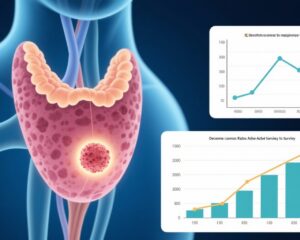Highlight
• Cisplatin treatment commonly results in decreased kidney function, with approximately 13.6% of patients developing chronic kidney disease (CKD) post-treatment.
• A simple predictive model based on baseline estimated glomerular filtration rate (eGFR) alone robustly forecasts post-cisplatin CKD risk and kidney function decline.
• Complex models integrating detailed clinical features, demographics, and symptoms do not improve prediction accuracy over the single-variable model.
• This evidence supports using pretreatment eGFR measures to guide risk stratification and personalized treatment planning to mitigate CKD development.
Study Background and Disease Burden
Cisplatin is a cornerstone chemotherapeutic agent extensively used to treat a variety of non-hematologic cancers. Despite its efficacy, cisplatin is associated with nephrotoxicity that can lead to acute kidney injury and contribute to the development of chronic kidney disease (CKD). CKD is a significant clinical concern because it adversely affects patients’ quality of life, increases morbidity and mortality, and complicates ongoing cancer care.
Although nephrotoxicity is an acknowledged adverse effect of cisplatin, the precise incidence of CKD following treatment and the ability to predict which patients will develop CKD remain incompletely understood. Improved prediction of CKD risk could enable clinicians to modify treatment regimens, enhance monitoring, and implement preventive strategies to preserve kidney function.
Study Design
This population-based prognostic study utilized a retrospective cohort design analyzing data from patients treated with cisplatin chemotherapy for nonhematologic cancers in outpatient settings. The derivation cohort included 9,521 patients treated between July 1, 2014, and June 30, 2017, in Ontario, Canada.
Prediction models were developed using comprehensive clinical and patient data including demographics, cancer type, cisplatin dose and schedule, comorbidities, laboratory values, and patient-reported symptoms. Models were validated in two external cohorts: a temporal-test cohort from Ontario (patients treated between 2017 and 2020) and a single-center external-test cohort in the United States.
The primary outcomes were the development of CKD, defined as an estimated glomerular filtration rate (eGFR) below 60 mL/min/1.73 m2, and continuous measures of post-treatment eGFR. Model performance was evaluated by the area under the receiver operating characteristic curve (AUC) for CKD prediction and mean absolute error (MAE) for eGFR estimation.
Key Findings
Among 9,010 patients without pre-existing CKD at baseline, 1,228 (13.6%) developed CKD after cisplatin treatment. Notably, 81 patients (0.9%) progressed to grade 4 or worse CKD, and 16 patients (0.18%) required dialysis, underscoring the clinical sequelae of nephrotoxicity.
The mean decline in eGFR following treatment was 8.1 mL/min/1.73 m2 (95% CI, 7.8-8.4), confirming a significant impact of cisplatin on kidney function.
A spline-based regression model using only pretreatment eGFR demonstrated strong predictive ability for posttreatment CKD, achieving an AUC of 0.80 (95% CI, 0.78-0.82) in the temporal-test cohort and 0.73 (95% CI, 0.66-0.78) in the external U.S. cohort. Similarly, posttreatment eGFR was predicted with reasonable accuracy by the same simple model, with MAEs of 12.6 and 14.3 mL/min/1.73 m2 in the temporal and external cohorts, respectively.
Importantly, complex machine learning models integrating all available clinical and symptomatic features failed to outperform these univariable models, indicating that pretreatment eGFR alone captures most of the predictive signal for CKD risk after cisplatin.
Expert Commentary
The findings reinforce the critical role of baseline kidney function assessment before cisplatin chemotherapy. The predictability of CKD development based on pretreatment eGFR emphasizes the biological plausibility that patients with compromised renal reserve are more vulnerable to cisplatin-induced nephrotoxicity.
While advanced machine learning approaches are often promoted for medical predictions, their lack of improvement here may be attributed to the limited additional signal in secondary features or variability in data quality across cohorts.
Clinicians should consider the use of this simple predictive tool to individualize therapy, potentially opting for dose adjustments, alternative regimens, or enhanced nephroprotective strategies in high-risk patients.
Limitations include retrospective design, potential confounders not captured in administrative data, and the external validation cohorts representing specific healthcare settings, which may affect generalizability.
Conclusion
This large-scale, population-level study delineated the incidence and predictability of CKD following cisplatin chemotherapy. Pretreatment eGFR serves as a robust, clinically practical predictor of CKD risk and post-treatment kidney function decline. Simple predictive models can aid in stratifying risk to guide treatment decisions, potentially mitigating long-term kidney damage and improving outcomes for cancer patients receiving cisplatin.
References
- Grant RC, He JC, Liu N, Podolsky S, Notta F, Ghassemi M, et al. Predicting Chronic Kidney Disease After Cisplatin Treatment Using Population-Level Data. JAMA Oncol. 2025 Aug 21. doi: 10.1001/jamaoncol.2025.2590. Epub ahead of print. PMID: 40839357.
- Kitchlu A, et al. Acute Kidney Injury and Long-Term Kidney Health after Cancer Treatment. Clin J Am Soc Nephrol. 2020;15(3):363-375.
- Nash K, Hafeez A, Hou S. Hospital-acquired renal insufficiency. Am J Kidney Dis. 2002;39(5):930-936.
- Launay-Vacher V, et al. Prevention of cisplatin nephrotoxicity: state of the art and recommendations from the European Society for Medical Oncology (ESMO). Oncologist. 2008;13(3): 246-251.



